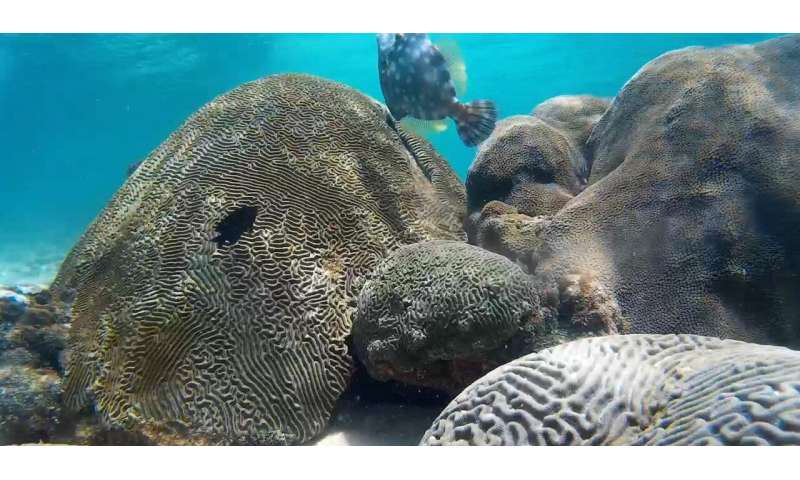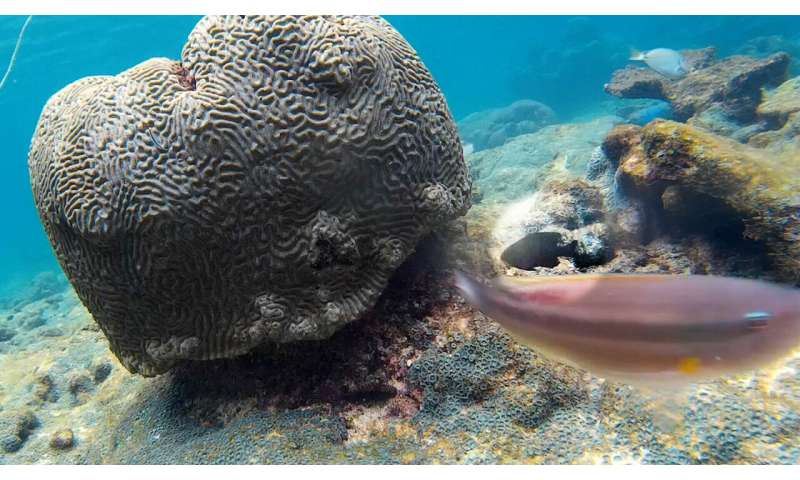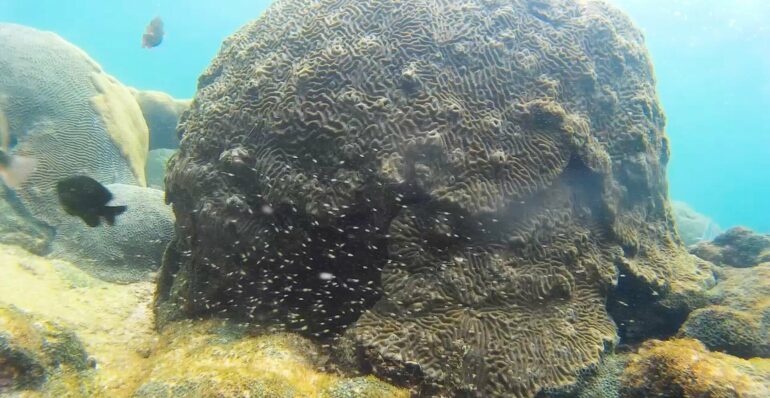Damselfish have been discovered to disrupt “cleaning services” vital to the health of reefs, and climate change may mean this is only likely to get worse.
The meal of choice for the Caribbean cleaner fish, the sharknose goby, is a platter of parasites, dead tissue, scales and mucus picked off the bodies of other fishes. By removing these morsels, gobies are offering their “cleaning services” to other marine life—a famous example of a mutually beneficial relationship between species.
But new research from the University of Cambridge and Cardiff University shows that when gobies inadvertently set up shop within the territories of aggressive damselfish, damselfish scare off the gobies’ “choosy client customers.”
The study, published today in Behavioral Ecology, is an example of a largely unexplored phenomenon: a mutually beneficial relationship in nature being disrupted by a third party.
Sharknose gobies work solo or band together and set up a “cleaning station,” a fixed location in a particular nook of coral reef, where other marine life burdened by parasites can go to take advantage of the gobies’ dietary needs.
“Gobies wait at cleaning stations for customers to visit, similar to shops. And with customers come the parasites,” said Dr. Katie Dunkley, a behavioral ecologist at the University of Cambridge’s Department of Zoology. “In return for providing a cleaning service, the gobies receive a payment of food.”
Customers are varied and include parrotfish, surgeonfish and butterflyfish. These choosy client fish shop around, visiting different cleaning stations open for business. If interested, they will adopt a stationary pose that makes a clean more likely—typically a head or tail-stand position with all fins flared.
During a cleaning—which could last from a few seconds to several minutes—gobies make physical contact with the customer, removing parasites and other dead body tissue. This is known as “tactile stimulation,” and as well as getting rid of parasites, it may act as a massage, reducing the customer’s stress, says Dunkley. Previous research has established the importance of cleaners—their removal led to fewer numbers and less variety of fish species on reefs.
“Cleaning stations act as a marketplace, and if customers stop showing up, over time a cleaning station is going to go out of business,” said Dunkley.
Five researchers spent over 34 hours observing cleaning stations on a shallow fringing reef in Tobago over a period of six weeks. Equipped with snorkels and waterproof paper, they recorded underwater interactions for 10-minute periods from 8 am-5:15 pm each day.
They found that client fish were less likely to go to cleaning stations that were more often patrolled by damselfish, who scared “intruders” away.
“I thought that damselfish might play a role as they visit cleaning stations too—although don’t often get cleaned—but to see just how influential they were was startling.
“Damselfish act like farmers as they weed out algae they don’t want, to encourage their preferred algae to grow. Damselfish are protective over their algal territories, and these anti-social fish spend a lot of time patrolling their territories, scaring away intruders through biting, attacking, chasing or threatening displays.”
Damselfish’s territories cover up to 70% of some reefs. On a healthy coral reef, a balance is maintained between algae and coral. But as reefs deteriorate and overfishing intensifies, algae thrive. As reefs deteriorate, damselfish may become more common and/or aggressive—leading to fewer species receiving the goby cleaning treatment needed to keep them healthy, says Dunkley. This could ultimately contribute to the breakdown of delicate ecosystems supported by reefs.

A damselfish seen with a filefish at a cleaning station. © Katie Dunkley

A damselfish disrupts a cleaning interaction and chases the client away. © Katie Dunkley
“In future we’d like to tease out the motives of damselfish. Are they driven by wanting to protect their algae farms or monopolize cleaning stations?” said Dunkley, a Charles Darwin and Galapagos Islands Fund Junior Research Fellow at Christ’s College, Cambridge.
“Just as humans are connected through family, friends and colleagues, all fish are connected to each other. It’s important that we don’t just look at relationships in isolated bubbles. We need to step back and see how all fish are connected so that we can protect ecosystems like coral reefs.”
More information:
Katie Dunkley et al, The presence of territorial damselfish predicts choosy client species richness at cleaning stations, Behavioral Ecology (2023). DOI: 10.1093/beheco/arac122
Provided by
University of Cambridge
Citation:
‘Anti-social’ damselfish are scaring off cleaner fish customers, which could contribute to coral reef breakdown (2023, February 22)


